Industrial Base Too ‘Brittle’ For Big War: Dunford
Posted on
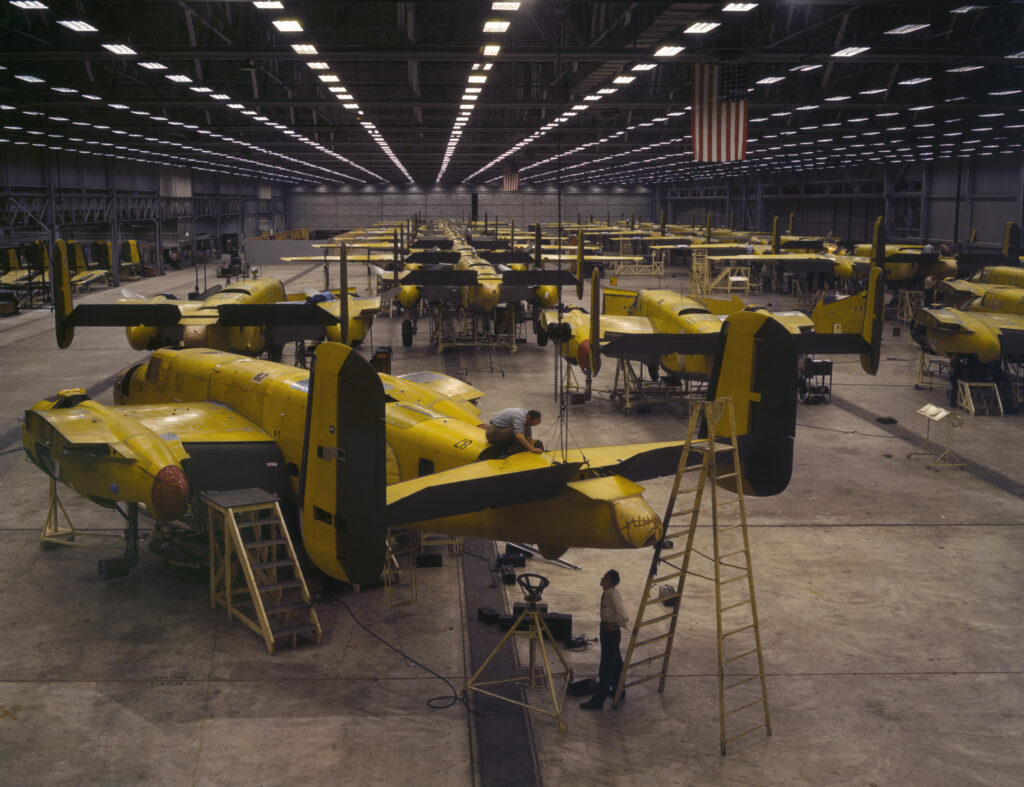
A rare color photo of workers assembling B-25 bombers during World War II.
CAPITOL HILL: Is the arsenal of democracy out of business? Probably not, but America’s “increasingly brittle industrial base” may not be able to sustain our forces in a protracted war, the Chairman of the Joint Chiefs, Gen. Joseph Dunford, warned the Senate in a written statement this morning. It’s a problem a lot of people are wrestling with, from Dunford’s subordinates on the Joint Staff to academics and a White House-commissioned task force. There are solutions, a panel of experts said this afternoon on the Hill – if we just invest enough to research and develop them.
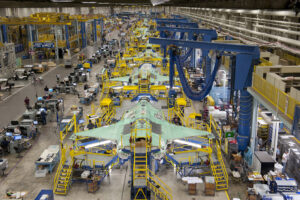
F-35 production line
The highest-level effort to find answers is that White House task force, commissioned by President Trump. “In the executive order, the analytical focus is on peer competitor conventional threats that would really stress all the different vectors of the industrial base,” an administration official told me, in contrast to the past 16 years of counterinsurgency, which only strained certain sectors like uparmored vehicles.
In the old days, when traditional defense contractors were tapped out, the military could turn to commercial companied. That’s no longer true. “In not just World War II, but Korea and Vietnam and the Cold War, you were able to draw from this manufacturing industrial base that was dual use. You had a vibrant automotive industry for instance,” the official said. “Today, the manufacturing capacity is just not there on the civilian side.”
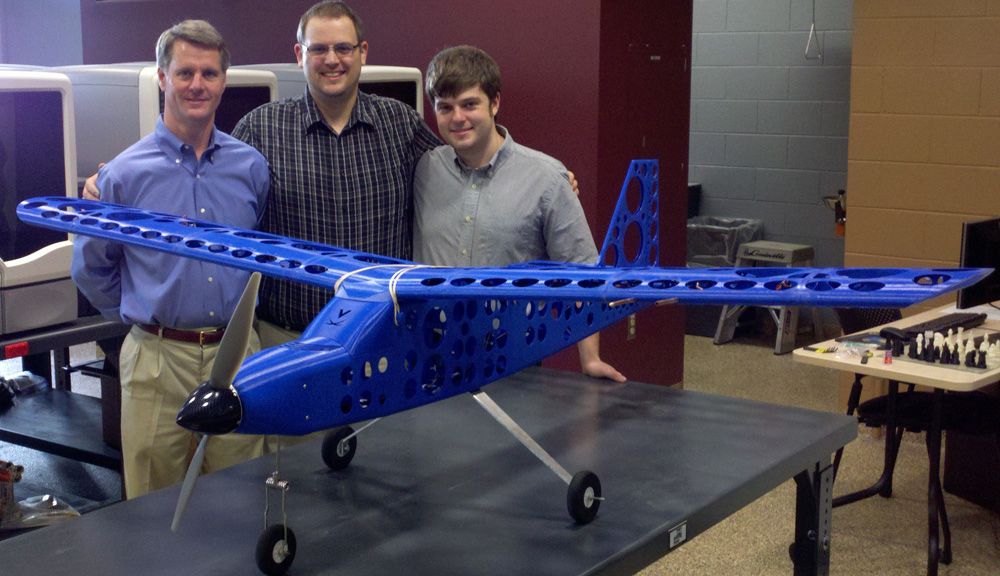
A working plane printed by graduate students at University of Virginia.
From Mass Production To 3D Printing? Maybe.
“In 1944, this country built 100,000 airplanes. (Today), we probably build 1,000-2,000,” from Cessnas to 787s, said John Langford, CEO of drone-maker Aurora Flight Sciences, to a panel co-sponsored by the AIA and AIAA. So, yes, the old-school industrial capacity no longer exists. But, Langford continued, “a lot of what we’re moving towards is manufacturing on demand, (e.g.) 3D printing.”
That suggests a radically different model for military logistics. Instead of manufacturing “iron mountains” of supplies in the US, then shipping them overseas, stockpiling them behind the battlefront, and finally distributing them to combat units – creating targets for enemy strikes all along the way – those units could have 3D printers to make their own spare parts and potentially even food and ammunition. The supply lines would still have to provide raw feedstock of various kinds, but that’s much simpler than delivering thousands of different parts to the right place at the right time.

A soldier holds a PD-100 mini-drone during the PACMAN-I experiment in Hawaii.
Better yet, the military doesn’t have to fund this additive manufacturing revolution on its own, because 3D printing technology is tremendously attractive to commercial industry all over the world. There are already, 3D printers in use everywhere from hobbyists’ desks to the International Space Station to, yes, military aircraft factories, and private sector R&D is going to keep making them better.
Another private-sector wave the Defense Department can catch is robotics, added Darryll Pines, dean of the Clark School of Engineering at the University of Maryland, speaking alongside Langford. For years, the US government led the development of drones, especially but not exclusively the military. (A NASA weather program funded initial development of what became the Predator B, said Langford). It was DARPA that kick-started development of autonomous ground vehicles with its Grand Challenge and Urban Challenge a decade ago. But now, companies from Tesla to Google to Uber to General Motors are investing in self-driving cars. That creates a lot of capacity and expertise that could be mobilized for military purposes in a crisis.
“Manufacturing to respond to a war demand would leverage…. advanced manufacturing and advances in robotics that will make us competitive,” Pines said.
There’s likewise a rush of commercial investment into space, even including some application of automotive
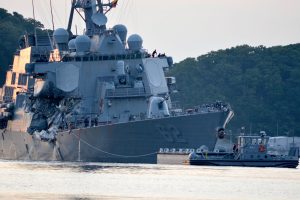
The damaged destroyer USS Fitzgerald pulls into Yokosuka, Japan after colliding with a commercial ship. Seven sailors died.
industry style mass production, said Mike Gazarik, VP of engineering at Ball Aerospace.
The new frontiers of technology are great, said the administration official, but war still requires old-fashioned industrial might to build ships, tanks, planes, and missiles. “There’s some advanced manufacturing stuff that’s pretty aggressive where we are world leaders, some nuclear and some energy stuff where we’re pretty dynamic,” he said, “but where we really struggle is in heavy industry. The conventional wisdom for so many years has been that we’ve moved past this industrial age manufacturing economy – but a great deal of what we do is 20th century industrial warfare.”
“The Fitzgerald and McCain collisions are test cases that are going to put severe strain on the ship repair industrial base – and these are not the same as taking a missile in your hull, these are collisions,” the official said. “If you start thinking about a wartime tempo of surface ship problems…. you’re really going to start stressing the ship repair industrial base.”
Especially worrying are the single points of failure, the chokepoints in the supplier base where a single small firm, often struggling to get by, is the only maker of some critical spare part. There’s little profit to be made on such components because they’re only needed in small numbers – at least until something goes badly wrong, like an accident or a war.
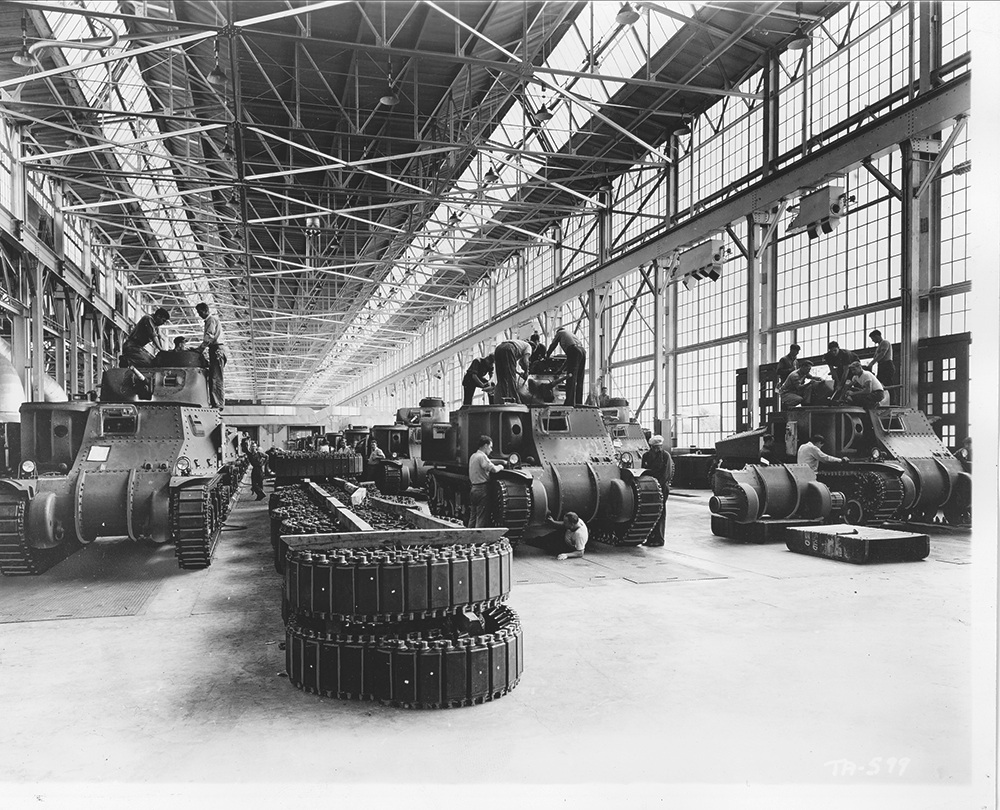
M3 tanks under construction during World War II.
The Disadvantages of Democracy
By contrast, the official said, our adversaries are willing to subsidize production of such key components, not to mention long-shot research that might one day yield some future weapon.
“China certainly has some advantages there….They are perfectly happy to build factories that don’t make economic sense but maybe produce the widget they need in some contingency,” the official said. “The Russians, they’re not lighting the word on fire with their dynamism but they’re certainly move focused on investing in capabilities, looking at the future…..The oligarchs are essentially an arm of the state. It’s a corporatist system.”
The US government and industry, by contrast, struggle to communicate with each other, let alone sticking to a shared strategy despite short term fluctuations in poll numbers and stock prices.
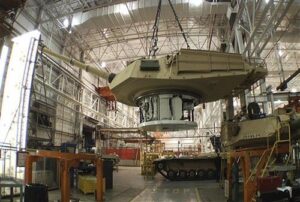
General Dynamics’ Lima tank plant, the only factory in the US capable of building main battle tanks.
There is “a grotesque imbalance” at many companies, said Anthony Velocci, who spent 10 years as editor of Aviation Week. Management focuses far too much attention on short-term shareholder value – often spending 100 percent of a company’s cash flow on stock buy-backs – while neglected long-term investments in new products – with R&D spending typically at just 2-3 percent of revenue. This near-sightedness is just one manifestation of a wider culture of risk aversion that hobbles innovation, he said. Rather than spend on “slick television ads that bracket the Sunday morning talk shows,” Velocci scoffed, companies need to invest in the future.
America’s lack of long-term perspective has hurt us in areas as diverse as quantum computing and hypersonics, areas where China is catching up, said Pines. In particular, he said, a boom-and-bust cycle of investment in hypersonic systems – which move at more than five times the speed of sound – is causing talented people to quit the field and take jobs they know will last.
Private industry has to live “quarter to quarter” on its price:earnings ratio and return on investment figures, Langford said, but government can take a longer perspective.
But government often doesn’t, said Gazarik. “It’s very non-linear, very hard to trace” an initial investment in research to a new working product many electoral cycles later, he said – and that makes R&D a hard sell to Congress.
Subscribe to our newsletter
Promotions, new products and sales. Directly to your inbox.
